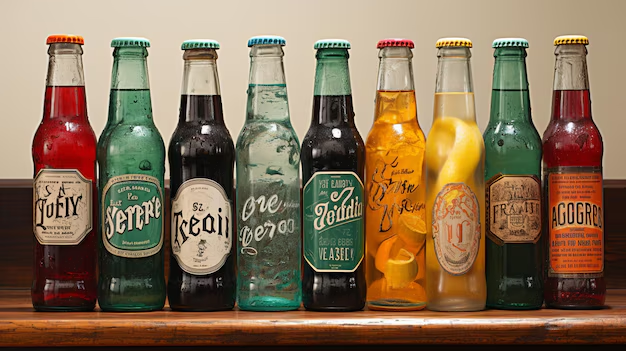Few beverages have carved as curious and memorable a niche in pop culture as Zimas. Known for its crystal-clear appearance, crisp citrus flavor, and quirky ‘90s marketing campaigns, Zima was more than just another alcoholic drink—it was a cultural moment. Whether you remember sipping it during its heyday, hearing about it from older siblings, or encountering it in retro TV references, the Zimas story blends innovation, consumer psychology, and shifting beverage trends.
This blog explores everything there is to know about Zimas—from its bold debut in the early 1990s to its short-lived comeback in the late 2010s, its marketing strategies, formulation, global footprint, and its enduring influence on today’s drink market.
Zima first appeared in 1993, a creation of the Coors Brewing Company. At a time when the American beverage market was becoming increasingly experimental, Coors wanted to create something distinctly different from traditional beer. The name “Zima,” derived from the Slavic word for “winter,” symbolized clarity, refreshment, and cool sophistication.
The company envisioned Zima as a “malternative”—a malt-based alcoholic drink that could appeal to those who didn’t enjoy beer’s bitterness or heaviness. Brewed from beer, then filtered to remove its amber color and much of its traditional taste, Zima presented itself as a lighter, sweeter, and visually unique option for social drinkers.
Coors didn’t just launch Zima—they unleashed it. Their marketing campaign embraced a playful “Z-language,” where words were given an extra “z” sound, producing slogans like “Zomething Different.” The idea was to make Zima stand out not only on store shelves but also in consumers’ minds.
Advertisements featured young, trendy individuals enjoying Zimas in sleek, urban settings, positioning the drink as modern and fresh. The clear bottle and crystal-like contents reinforced the idea of purity, minimalism, and novelty. This strategy aligned perfectly with the 1990s “clear craze,” a cultural trend in which consumers were fascinated by see-through products, from Crystal Pepsi to transparent electronics.
Upon launch, Zima created a buzz. In its first year alone, Coors sold over 1.2 million barrels in the U.S.—a significant achievement for a brand-new category of drink. Many early adopters appreciated its smooth, citrus-forward flavor, which felt refreshing compared to heavier beers.
However, Zima also faced skepticism. Some drinkers found it overly sweet, while others considered it “unmasculine” due to its lighter profile and fruity taste. In a beer market that was still strongly shaped by traditional masculinity cues, this perception limited its long-term growth among certain demographics.
| Year | Event | Impact |
|---|---|---|
| 1993 | Peak popularity in the U.S. | Instant buzz and strong first-year sales |
| 1994 | The product remains available in Japan | Over 1.2 million barrels sold |
| 1996 | Sales start to decline | Competition and shifting tastes emerge |
| 2000 | Reformulation attempts | New flavors fail to reignite widespread interest |
| 2008 | U.S. discontinuation | Demand is insufficient for permanent return |
| 2017 | Limited U.S. comeback | Nostalgia-driven sales spike |
| 2018 | End of comeback | Demand insufficient for permanent return |
| 2021 | Japanese production ends | Global discontinuation complete |
Zima’s release wasn’t an isolated event—it was part of a larger marketing phenomenon. The early 1990s saw a wave of “clear” products across multiple industries. Marketers linked transparency with purity, health, and innovation. In beverages, this meant developing drinks that not only tasted different but also looked dramatically different.
Crystal Pepsi is perhaps the most famous example of this fad. While that cola brand faded quickly, Zima managed to linger for over a decade thanks to its positioning as an alcohol alternative, rather than as a replacement for a beloved staple like cola. Still, the clear craze eventually lost steam, and products relying solely on novelty struggled to survive.
At its core, Zima was a beer that had undergone a special filtration process. Coors started with a lager and passed it through charcoal filters, stripping it of color and altering its flavor profile. The resulting liquid was flavored with citrus notes and lightly carbonated.
The flavor was described as sweet yet crisp, with a tangy finish. It wasn’t as sugary as a wine cooler, but sweeter than most beers. Its alcohol content hovered between 4.7% and 5% ABV, putting it on par with a standard light beer.
Many fans enjoyed Zima straight from the bottle, while others experimented by adding fruit slices or even dropping candy into the drink to tweak its flavor. Jolly Ranchers were a particularly popular mix-in, creating brightly colored, extra-sweet concoctions.

Zima’s unique identity made it a pop culture talking point. In TV comedies and late-night sketches, it was often used as a punchline—mocked for being too sweet, too light, or too “trendy.” Despite (or perhaps because of) this teasing, Zima became a cultural marker of 1990s social life.
By the early 2000s, Zima’s image had shifted from cutting-edge to nostalgic. Millennials who had grown up seeing Zima in commercials often looked back on it as a quirky relic of the past. This nostalgia would play a central role in its brief 2017–2018 comeback.
When Zima’s popularity began to decline in the U.S., it found a surprising second life in Japan. There, it was marketed not as a novelty drink, but as a lifestyle choice. Advertising focused on Zima as a casual, easy-drinking option for young adults at parties, concerts, and beach gatherings.
Without the same gendered marketing hang-ups that plagued its U.S. image, Zima managed to stay relevant for years. It became a staple at convenience stores and music festivals. Unfortunately, production in Japan ended in 2021, largely due to pandemic-related disruptions and changing market conditions.
In summer 2017, Molson Coors decided to reintroduce Zima to the U.S. for a limited time. The move was pure nostalgia marketing, targeting consumers who remembered Zima from their younger days and younger drinkers intrigued by retro trends.
The campaign worked, at least temporarily. Social media buzz spread quickly, with people posting photos of themselves holding the iconic clear bottle. Limited-edition runs sold out in some markets, proving that the brand still had a spark of magic left.
However, by 2018, the novelty wore off. The drink once again disappeared from shelves, overshadowed by the explosive rise of hard seltzers like White Claw, which offered a similar light drinking experience but with lower calories and a broader variety of flavors.
When you compare Zima to today’s hard seltzers, it’s easy to see how it was both ahead of its time and slightly out of step with consumer demands.
| Attribute | Zima (1990s–2000s) | Modern Hard Seltzers |
|---|---|---|
| Alcohol Base | Clear malt beverage | Fermented cane sugar or malt |
| ABV | ~4.7% | 4–5% |
| Calories | ~150 per bottle | 90–110 per can |
| Flavor Profile | Sweet citrus | Broad variety: fruit, botanical, tropical |
| Marketing Position | Beer alternative novelty | Health-conscious, lifestyle-friendly |
Zima anticipated the shift toward lighter, flavored alcohol but didn’t benefit from the health-conscious marketing approach that makes today’s hard seltzers so popular.
The Zimas journey offers valuable insights into product development, branding, and consumer psychology.
Novelty sparks curiosity but doesn’t guarantee loyalty. Zima’s initial sales were fueled by its unique look and positioning, but without a deep connection to consumers’ long-term preferences, novelty faded.
Cultural alignment matters. In Japan, Zima fit seamlessly into social drinking culture, free from the baggage of gendered perceptions. In the U.S., it never fully overcame the stigma of being “unmanly.”
Timing is critical. Zima arrived before the ready-to-drink boom and wellness-oriented alcohol trend. If launched today with a reformulated low-calorie version, it might succeed where it once failed.
Nostalgia has limits. While retro branding can drive short-term excitement, it rarely sustains sales without product innovation.
Zimas remain a fascinating chapter in the history of alcoholic beverages. What began as a bold experiment in the 1990s became a cultural talking point, a case study in marketing, and an early sign of where consumer tastes were heading. Although the brand is now fully discontinued worldwide, its influence lingers in the DNA of modern hard seltzers and flavored malt beverages.
For those who experienced Zima firsthand, it’s a nostalgic reminder of a decade obsessed with newness, clarity, and quirky branding. For others, it’s a symbol of how fleeting trends can still leave lasting marks on culture and commerce. Zimas may never return to store shelves permanently, but they’ve secured a permanent place in beverage lore.
Mastering SFM Compile: The Complete Guide for Animators and Technical Creators
What is Zima?
Zima was a clear, citrus-flavored malt beverage launched by Coors Brewing Company in 1993, designed as an alternative to beer and part of the 1990s “clear craze” trend.
Why was Zima discontinued?
Declining U.S. sales, increased competition from other flavored alcoholic drinks, and shifts in consumer preferences led to its discontinuation in 2008, despite a later limited return.
Is Zima still available anywhere?
Production continued in Japan for years after its U.S. discontinuation, but it officially ended worldwide in 2021.
How does Zima compare to modern hard seltzers?
Zima shared the same alcohol content range as hard seltzers but was sweeter and higher in calories, with fewer flavor options and less emphasis on health-conscious marketing.
Did Zima ever make a comeback?
Yes, Zima briefly returned to the U.S. in the summers of 2017 and 2018, appealing to nostalgia, but the relaunch ended after limited seasonal runs.

